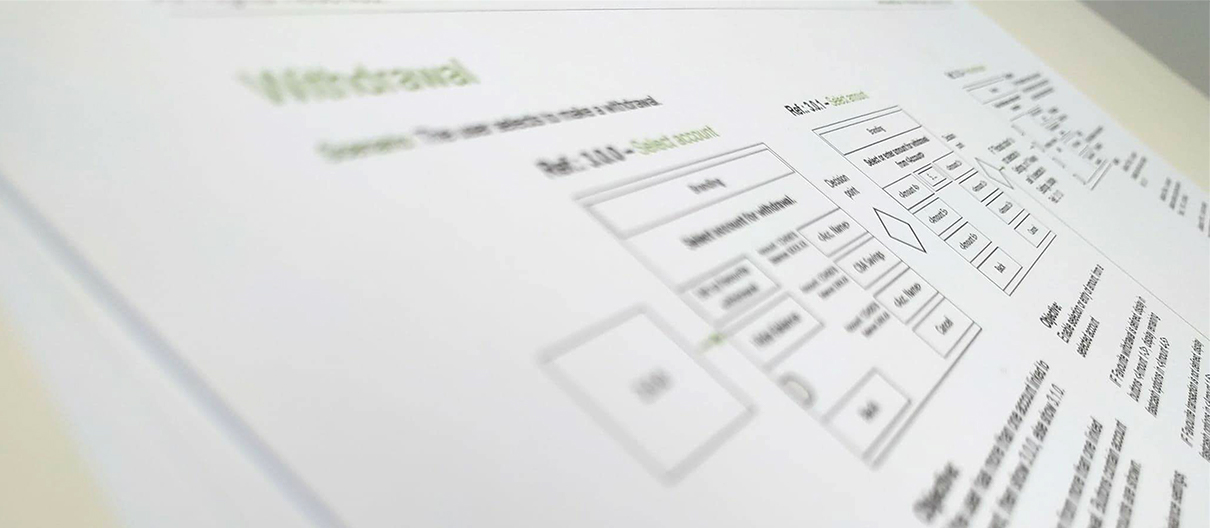Bank ATM research and user experience design
Applying user research and participatory co-design methods to create an intuitive and accessible user experience.
CXCO was engaged to gather insight and provide design direction for the experience for a new ATM fleet rollout by a leading Australian retail bank. The project required us to gather insight on customers’ needs, expectations and tasks when using ATMs, design the user interaction flow and experience, and define content and language guidelines to ensure the experience met users’ needs and requirements.
We facilitated participatory design sessions to gain insight into the ideal experience, language, labels and instructions on the ATM interface, and to prototype and test concepts with Customers and Bank Staff. The focus was on accessible and universal design, with inclusion of blind and hearing-impaired Customers.
The insight from the blind and hearing-impaired customers was invaluable as it provided insight into their tactical and sensory needs, their mental models, and what accessibility really meant to them. This insight highlighted the need to consider support touchpoints and channels, such as ATM search functions on the website, and ATM locators available through mobile apps and touch devices.
The opportunity
Our client was due to replace their ATM fleet, and saw an opportunity to implement ATMs that provided greater functionality to users. The ATM is the customers’ most frequently used touchpoint, yet prior to this project key functionality that was available to customers in branch, online, and on competitors ATMs was not available on our Client’s ATMs.
The current ATM experience was lacking a number of key functions to enable customers to self-service including bill payment, multi-lingual access, fast-cash options, ease in making cash deposits and ability to save a favourite transaction.
A key driver for this project was the organisation’s 3-year transformation strategy to becoming a customer-centred organisation, and the primary objective of the project was to improve the customer ATM experience. The organisation’s core strategy was an important component to ensure alignment and integration of strategic priorities with business, service and technical product design.
The business had shortlisted ATMs with the required capabilities, but was lacking insight into the end-to-end user experience, language, and error messages. Integral to project success was collaboration with business representatives on the proposed design to ensure it could be implemented within retail bank's operations and delivery framework.
Our approach
 Project initiation
Project initiation
A kick-off workshop with multiple business, technical and delivery stakeholders from across the organisation was conducted to establish strong relationships to support delivery, and ensure business implementation was aligned to the organisation’s strategic intent.
 Contextual research
Contextual research
In collaboration with our Client’s stakeholders CXCO designed, developed and conducted contextual inquiries and surveys with ATM users across metro and regional locations. This included identifying points of failure with the current ATM experience. CXCO also conducted a comparative review of 5 ATMs, and user testing of the proposed base function ATM interface to identify failure points.
 Participatory design
Participatory design
CXCO facilitated participatory design sessions with customers and bank staff to understand user’s expectations, needs and scenarios of use, and explore the interface design, messaging, and functions. Accessibility requirements were gained by conducting workshops with representative customers from Vision Australia, several disability associations and our client's diversity team.
 Concept design and user testing
Concept design and user testing
Insights, opportunities and recommendations for the future ATM experience were communicated to our client through findings, design principles and guidelines. Subsequently, CXCO iteratively developed conceptual designs informed by the user research and tested these with representative users. UX deliverables included UX wireframes, process flows and interaction flows.

Key outcomes
 Customer research activities provided insight into customers’ mental model and modes of use, and informed the design of an improved ATM user experience.
Customer research activities provided insight into customers’ mental model and modes of use, and informed the design of an improved ATM user experience.
 The human-centred approach ensured customer requirements and high-value features were understood before selection of an ATM vendor and technology solution, saving implementation and customisation time and costs.
The human-centred approach ensured customer requirements and high-value features were understood before selection of an ATM vendor and technology solution, saving implementation and customisation time and costs.
